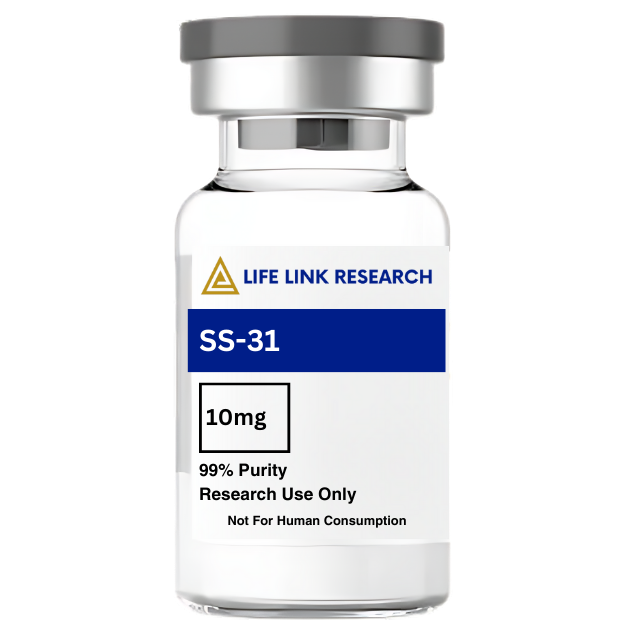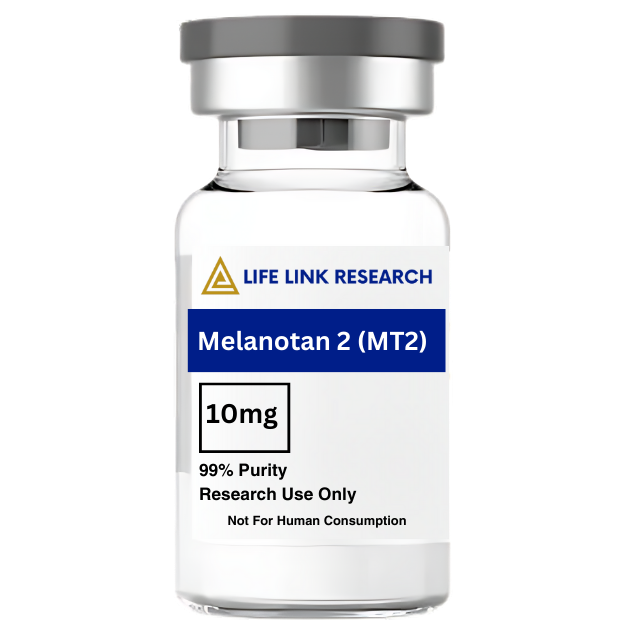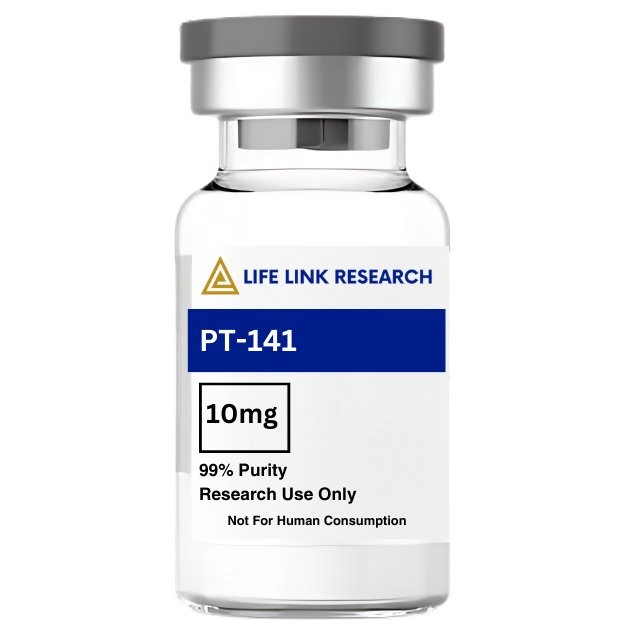SS-31 10mg
$58.00
Out of stock
Buy 3 to Get 5% OFF
Buy 5 to Get 10% OFF
Buy 10 to Get 20% OFF
Product Usage: This PRODUCTS ARE INTENDED FOR RESEARCH CHEMICAL ONLY. This designation allows the use of research chemicals strictly for in vitro testing and laboratory experimentation only. All product information available on this website is for educational purposes only. Bodily introduction of any kind into humans or animals is strictly forbidden by law. This product should only be handled by licensed, qualified professionals. This product is not a drug, food, or cosmetic and may not be misbranded, misused, or mislabeled as a drug, food, or cosmetic.
SS-31 helps improve mitochondrial function and overall production of energy via ATP synthesis. Research has shown its ability to reduce inflammatory cytokines which cause oxidative stress and inflammatory diseases such as Alzheimer’s, Parkinson’s, heart disease, diabetes, kidney disease, and more.
Structure
Sequence: D-Arg-Tyr(2,6-diMe)-Lys-Phe Molecular Formula: C32H49N905
Molecular Weight: 639.8 g/mol
PubChem CID: 11764719
CAS Number: 736992-21-5
Synonyms: elamipretide, MTP-131, Bendavia

Source: PubChem
SS-31 Research
Mitochondria Improvement
Primary mitochondrial diseases (PMDs) are among the most common inherited conditions in the world. They are caused by dysfunction in the energy-producing apparatus of mitochondria. Symptoms vary greatly between forms of the disease, but the most susceptible organ systems are those with high energy demands (e.g. nervous system, heart, kidney, etc.). Muscle involvement and exercise intolerance are almost universal in mitochondrial disorders. Common symptoms include easy fatigue, exercise intolerance, and seizures.
PMDs, and mitochondrial diseases in general, are primarily characterized by disturbances in the production of ATP. ATP acts as the energy currency of the cell and is necessary for almost every cell function. Stabilizing ATP production in the setting of mitochondrial disease has long been a goal of the medical profession. With the development of SS-31, that goal may finally have been realized.
The first evidence that SS-31 could restore energy production in PMDs came from animal studies. In that research, rats who had suffered ischemia perfusion injury (a non-genetic cause of mitochondrial disease) of the kidney were given SS-31. The peptide protected kidney structure, accelerated recovery of ATP production, and reduced cell death and necrosis within the kidney[1]. Subsequent studies in mice showed that SS-31 interacted with cardiolipin in the inner mitochondria membrane and revealed that the peptide could reduce symptoms of mitochondrial disease regardless of etiology. There is also evidence that it can improve mitochondrial dysfunction that results from age[2]-[4]. From these findings, it was relatively simple to convince the FDA to grant orphan drug status to SS-31 and pave the way to clinical trials.
In phase II trials in humans, SS-31 increased exercise performance after just 5 days of treatment and showed no safety concerns or prominent side effects[5]. Unfortunately, phase Ill trials failed to produce convincing evidence of SS-31’s clinical utility[6]. That said, there is good reason to believe that the trial endpoints simply weren’t appropriate and that additional work will result in the peptide being approved for the treatment of certain mitochondrial conditions. According to Dr. Bruce Cohen, director of the Neurodevelopment Science Center at Akron Children’s Hospital, the results for prior phase II clinical trials were very encouraging so it is not time to give up. Rather, he notes, SS-31 should spur interest in this particular area and bring other big pharma research to the table[7]. It appears that that is already happening as the company that first brought SS-31 to clinical trials is planning to move forward with trials of a derivative of SS-31 as well as trials investigating other endpoints for SS-31 treatment[6].
As of right now, SS-31 is being tested in a number of different human diseases and under a number of different trial models. The peptide is considered safe to use in humans, so it can also be prescribed by doctors under compassionate care exceptions to patients who have no other treatment options. The peptide will likely become part of mainstream medical care for a number of conditions in the near future, but even now it is available to people who need it while clinical trial work is ongoing.
lschemia
Perhaps the most compelling secondary application of SS-31 is in the treatment of heart failure. It has long been known that heart failure causes negative changes to the function of mitochondria and that these changes, in a kind of destructive cycle, cause heart failure to worsen. Research in human heart tissue treated with SS-31 shows significant improvements in mitochondrial oxygen flux and activity of specific components involved in the production of ATP. This particular study was carried out in a manner that precluded cardiolipin restructuring, however, suggesting that SS-31 may have a second mechanism of action on mitochondrial function that needs to be explored[4]. This finding has actually been replicated in a number of research studies, strengthening the idea that SS-31 is not just useful for restoring ATP production via cardiolipin interaction. The peptide is actively being investigated for its ability to alter the production of reactive oxygen species and improve mitochondrial function in both acute and chronic use situations.
Studies in dogs, for instance, show that chronic treatment with SS-31 can improve left ventricular function in the setting of advanced heart failure. Measures of mitochondrial respiration and maximum ATP synthesis correlated well in this study with overall improvement in left ventricular function implying that SS-31 could be an effective long-term treatment for improving energy dynamics and reducing cardiac remodeling in advanced heart failure[8].
Trials exploring the use of SS-31 in ST-segment elevation myocardial infarction (heart attack) found that the peptide can drastically reduce levels of HtrA2. HtrA2 is a measure of cardiomyocyte apoptosis. These results suggest that SS-31 may be useful in the context of acute heart attack to reduce the extent of injury and preserve cardiac tissue[9].
One role of mitochondrial-targeted therapy in heart failure:

Source: PubChem
Diabetes
Diabetes, while seemingly caused by a simple inadequacy in insulin secretion or function, is a complex condition with multiple pathophysiologic manifestations. In recent years, there has been growing interest in the role of mitochondrial impairment in the pathogenesis of the disease, particularly in type 2 diabetes. Treating mitochondrial dysfunction would thus be a way to ameliorate some of the long-term consequences of diabetes such as oxidative damage to small vessels. In a study of humans given SS-31, a marked decrease in the production of reactive oxygen species was observed. This suggests that SS-31 can help to reduce the oxidative damage that usually accompanies mitochondrial dysfunction and may therefore slow or halt the progression of microvascular disease in type 2 diabetes. This hypothesis is further confirmed by the finding, in the same study, that SS-31 increased levels of SIRT1. SIRT1 levels have been associated with improved insulin sensitivity and reduced inflammation in type 2 diabetes[10].
Reduces Inflammation
A theme throughout the sections above is inflammation and the ability of SS-31 to reduce it. In particular, SS-31 appears to be a potent regulator of reactive oxygen species (free radicals) and thus helps to reduce the serious oxidative stress that arises from long-term illnesses such as diabetes, heart disease, and more. Research in cell cultures suggests that SS-31 reduces inflammation and oxidative stress by reducing expression of FIS1[11]. FIS1 is a mitochondrial protein that is important for mitochondrial growth and division. Elevated levels of FIS1 have been observed in a number of neurodegenerative diseases as well as a variety of cancers and are thought to be evidence of dysfunctional mitochondrial division secondary to dysfunction and inflammation.
There is also good evidence from mouse models to show that SS-31 reduces levels of the inflammatory cytokine CD-36, reduces expression of activated MnSOD, suppresses NADPH oxidase function, and inhibits NF-kappaB p65[12]. All of these are markers of high oxidative stress, so reducing their levels is indicative of reduced free radical production and an improved inflammatory status in the cell. NF-kappaB expression, in particular, is heavily associated with cellular inflammation and is chronically active in a number of inflammatory diseases like rheumatoid arthritis and inflammatory bowel disease. With SS-31, mitochondria do not undergo inflammasome activation, which is to say they don’t convert from the primary production of ATP to primarily producing ROS.
lnflammasome activation is avoided and normal mitochondrial function is preserved in the setting of SS-31 administration:

Source: ResearchGate
SS-31 Summary
Though SS-31 was originally of interest because it is thought to regulate mitochondrial function in the setting of mitochondrial disease, there is also good evidence that the peptide can regulate mitochondria-induced inflammation. There is a lot of active interest in using SS-31 to improve mitochondrial function and thus overall production of energy via ATP synthesis. Though initial phase Ill trials were not successful, it is thought that this may be more a result of the endpoints measured as opposed to a true failure of the peptide to have any effect. Currently, there are ongoing phase II trials and planned phase Ill trials to test SS-31 in a variety of different disease states and with a variety of different outcome measures. SS-31 may very well provide the key to understanding mitochondrial dysfunction in a variety of diseases and thus may prove useful in designing advanced treatments for Alzheimer’s disease, Parkinson’s disease, heart disease, diabetes, kidney disease, and more.
Article Author
The above literature was researched, edited and organized by Dr. Logan, M.D. Dr. Logan holds a doctorate degree from Case Western Reserve University School of Medicine and a B.S. in molecular biology.
Scientific Journal Author
In his work to uncover treatments for patients with mitochondrial diseases, Dr. Cohen has become one of the world’s leading experts. Although there are no cures for mitochondrial diseases, Dr. Cohen looks for one every day. As a result of his work and our hospital’s commitment to helping him build an infrastructure for conducting mitochondrial clinical trials, Akron Children’s is one of the country’s leading institutions researching treatments. Before joining Akron Children’s, Dr. Cohen served as chief of pediatric neurology for Cleveland Clinic. He received his medical degree from the Albert Einstein College of Medicine and completed his pediatric residency at Children’s Hospital of Philadelphia, pediatric neurology residency at Columbia Presbyterian Medical Center and his American Cancer Society neuro-oncology fellowship in Philadelphia.
Bruce H. Cohen, M.D. is being referenced as one of the leading scientists involved in the research and development of SS-31. In no way is this doctor/scientist endorsing or advocating the purchase, sale, or use of this product for any reason. There is no affiliation or relationship, implied or otherwise, between Life Link Research and this doctor. The purpose of citing the doctor is to acknowledge, recognize, and credit the exhaustive research and development efforts conducted by the scientists studying this peptide. Dr. Cohen is listed in [5] under the referenced citations.
Referenced Citations
2. M. P. Siegel et al., “Mitochondrial targeted peptide rapidly improves mitochondrial energetics and skeletal muscle performance in aged mice,” Aging_ Cell, vol. 12, no. 51 RR.:. 763-771, Oct. 2013, doi: 10.1111/acel.12102.
3. A. V. Birk et al., “The Mitochondrial- Targeted Compound SS-31 Re-Energizes lschemic Mitochondria by Interacting with Cardiolipin,” J. Am. Soc. Nephol JASN, vol. 24, no. 8, RR.:. 1250-1261, Jul. 2013, doi: 10.1681/ASN.2012121216.
4. K. C. Chatfield et al., “Elamipretide Improves Mitochondrial Function in the Failing Human Heart.” JACC Basic Transl. Sci., vol. 4, no. 2, pp. 147-157, Apr. 2019, doi: 10.1016ljjacbts.2018.12.005.
5. A. Karaa. R. Haas. A. Goldstein. J. Vockley..1 W. D. Weaver, and B. H. Cohen,
“Randomized dose-escalation trial of elamipretide in adults with prima[Y mitochondrial myopathy,” Neurology, vol. 90, no. 14, pp. e1212-e1221, Apr. 2018, doi: 10.1212/WN L.0000000000005255.
8. H. N. Sabbah, R. C. Gupta, S. Kohli, M. Wang, S. Hachem, and K. Zhang, “Chronic Therapy. With Elamipretide (MTP-131)a Novel Mitochondria-Targeting Peptide, Improves Left Ventricular and Mitochondrial Function in Dogs With Advanced Heart
Failure,” Gire. Heart Fail., vol. 9, no. 2, e002206, Feb. 2016, doi:
10.1161ICIRCHEARTFAILURE.115.002206.
11. Y. Mo et al., “SS-31 reduces inflammation and oxidative stress through the inhibition of Fis1 expression in lipopolysaccharide-stimulated microglia,” Biochem. Biophys. Res. Commun., vol. 520, no. 1, pp. 171-178, Nov. 2019, doi: 10.1016/j.bbrc.2019.09.077.
13. Y. Hou et al., “Mitochondria-targeted peptide SS-31 attenuates renal injury. via an antioxidant effect in diabetic nephropathy. Am. J. Physiol.-Ren. Physiol., vol. 310, no. 6, pp. F547-F559, Dec. 2015, doi:
10.1152/ajprenal.00574.2014.
ALL ARTICLES AND PRODUCT INFORMATION PROVIDED ON THIS WEBSITE ARE FOR INFORMATIONAL AND EDUCATIONAL PURPOSES ONLY.
The products offered on this website are furnished for in-vitro studies only. In-vitro studies {Latin: in glass) are performed outside of the body. These products are not medicines or drugs and have not been approved by the FDA to prevent, treat or cure any medical condition, ailment or disease. Bodily introduction of any kind into humans or animals is strictly forbidden by law.




